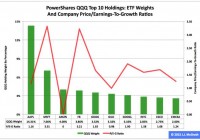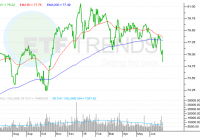RSX: Bear Thesis In Progress
Summary The Greek drama and news that sanctions on Iran could be lifted put serious pressure on oil prices. The Ruble will continue to weaken. The Saudi deal does not impact the short thesis. I’ve recently written an article on the Market Vectors Russia ETF (NYSE: RSX ), where I outlined my bear thesis on the Russian market. The situation evolved fast. When the initial article was published, Brent oil was trading near $63. As I am writing this article, Brent oil trades at $57.50 after it touched $55.60. This was a spectacular movement, and I even got a message from a reader who was wondering whether it was time to buy RSX. The rationale of such thesis is quite simple – oil often rebounds after big moves. I think that this reader was not the only one wondering whether the plunge in oil was the opportunity to buy RSX at cheaper prices, so I decided to write a follow-up on my initial thesis. The Russian ruble – not as weak as I expected My initial thesis consisted of three main points: Russian ruble will weaken, the economy will continue to suffer and oil will drop. I will revisit them one by one. Since June 26, the ruble tumbled 4% against the dollar. The movement against the basket of currencies, which consists of dollar and euro, was more modest. I expected that ruble would be weaker. Many factors affect the value of the Russian currency, but the main factor is the price of oil. The oil price is the key variable for both the Russian economy and the Russian budget. It’s the price of oil in rubles that matters for the Russian budget. In the end of 2014, several Russian officials stated that the “comfortable” price of oil was 3600 rubles per barrel. However, as oil plunged and ruble tumbled, stabilization of the national currency became a top priority. Back in June 26, the oil price denominated in rubles was 3467. As I’m writing this article, the price of oil fell to 3277 rubles. In my initial article, I stated that the Russian budget was stretched. At the same time, the Russian Central Bank started to buy dollars at the open market to bring the country’s reserves back to $500 billion. I think that the price of oil in rubles will soon drift towards 3400-3500 level – either by forces of the market or with a little help from the Russian Central Bank. Even if oil prices stay at current levels, this will lead to further weakness of the ruble and put pressure on dollar-denominated RSX. The economy – deal with Saudi Arabia does not change the big picture Many readers already know that Saudi Arabia decided to invest up to $10 billion in Russia over the next five years. Some people speculate that some of this money could end up on the stock market. In my view, this will not be the case. What is important is the duration of the deal – five years, and the sectors – agriculture, medicine, logistics, retail and real estate. While the economy matters a lot when you buy a Russian market ETF, the fate of the actual holdings of this ETF matters more. The majority of the money will be spent on agricultural projects, and there is no agricultural producers in RSX’s holdings . Among related companies, Uralkali, the Russian producer of potash, accounts for just 2.02% of RSX’s holdings. All in all, I think that this news do not change the bear thesis. The oil plunge The Greek drama and news that sanctions on Iran could be lifted put serious pressure on oil prices. In my view, the story is far from its end. I think that oil still has room to fall, especially if the nuclear deal with Iran is successful. As I highlighted in my initial article, I believe that there is a structural imbalance between supply and demand. In my opinion, the strength of oil prices’ reaction to negative news confirms this thesis. Bottom line Let me guess your ultimate bullish argument: in a five-year period, Russian market will be higher as oil rebounds, sanctions are lifted and investors realize how cheap Russian stocks are. That may be true. However, a bearish thesis on a country is by definition not designed for five-year time frames. In shorter time frames, the bearish thesis remains valid. I expect that weaker ruble, poor economy and falling oil will continue to put pressure on RSX. Disclosure: I am/we are short RSX. (More…) I wrote this article myself, and it expresses my own opinions. I am not receiving compensation for it (other than from Seeking Alpha). I have no business relationship with any company whose stock is mentioned in this article.

